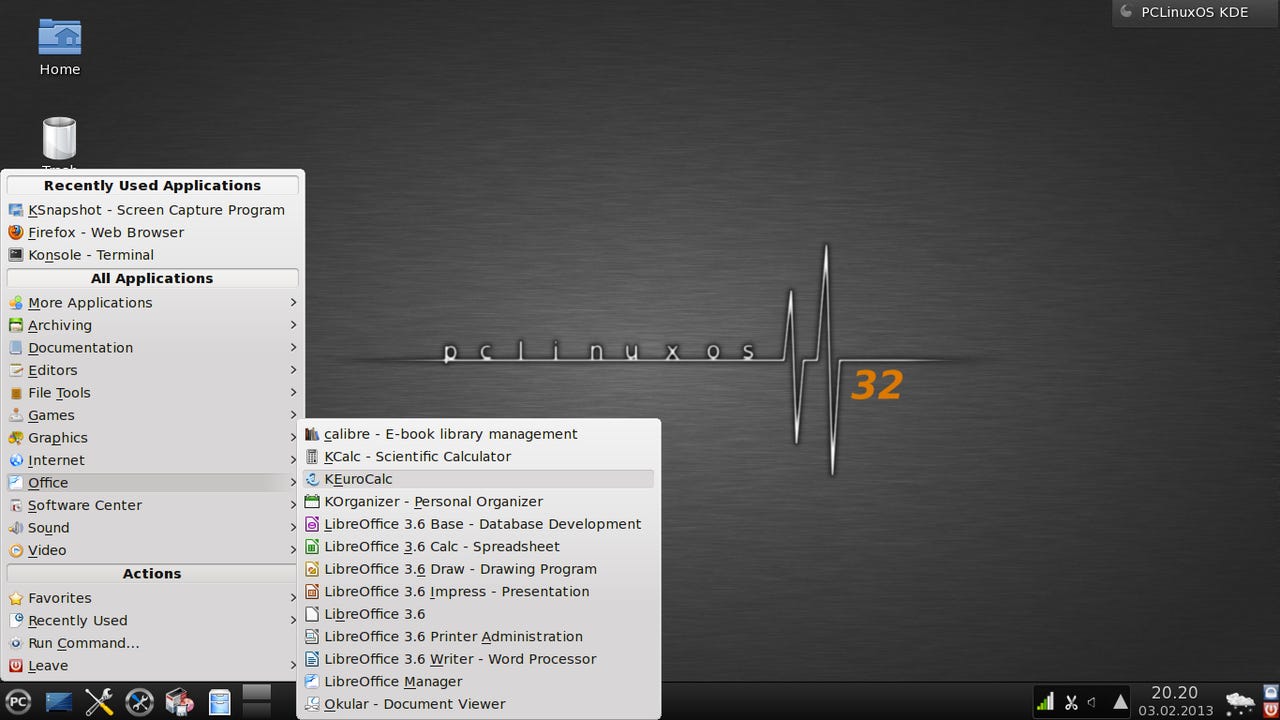PCLinuxOS quarterly rollup release: Hands on

PCLinuxOS is an "old standard" Linux distribution. Although it doesn't seem to have been getting as much attention recently it still seems to have a significant number of very loyal followers.
The strength of PCLinuxOS today is in stability, and a very active and dedicated user community.
It includes an excellent array of applications and utilities in the base distribution, so for many purposes it is ready to use right out of the box. If you try it and have problems of any kind, you can generally get very capable help from the PCLinuxOS User Forums very quickly.
PCLinuxOS is supposed to be a "rolling release", with continuous updates and quarterly roll-ups into fresh ISO images to make scratch installation easier. However, the last ISO release that I was aware of was 2012.08, so unless I missed something I would say this is not exactly "quarterly".

The Release Announcement gives a good overview of this release. It seems that the two most significant updates are to Linux kernel 3.2.18 and KDE 4.9.5. Of course, the biggest advantage of this release is for new installations, because after installing from the Live media, there are only a handful of updates to install, rather than the very large number of updates which had accumulated since the list ISO distribution.
After having installed (or at least tried to install) on most of my computers, I have a short list of comments and warnings:
- Compared to distributions like Fedora, openSuSE, Ubuntu and Mint, the Linux kernel is a number of point-releases old (most of those are currently on at least 3.5.x, and the newest stable kernel available is 3.8.x). This is significant if you have a very new computer, especially a very new laptop, because there may well be hardware which is not yet supported by the 3.2.x kernel. The Ralink 3290 WiFI card in my HP Pavilion dm1-4310 was not supported, for example.
- The PCLinuxOS installer still creates an X11 config file (for graphic support) on the fly during installation, and it still doesn't get it right sometimes. The usual symptom of this is that your display come up at the wrong resolution (a couple of my 1366x768 laptops came up at 1024x768 or 800x600, for example). The simple solution is to just delete or rename the file /etc/X11/xorg.conf - the X window server has been capable of figuring out the graphic configuration on the the fly for quite some time now.
If you have one of the more difficult graphic cards which require a special configuration file, you can fix this up after the installation is complete.
- PCLinuxOS doesn't seem to have provisions for UEFI-boot systems.
- The biggest problem I had was that the PCLinuxOS installer seemed to get confused by the gpt partition table on my new HP dm1-4310. It didn't complain or warn me about it, but when I ran the installation it put both the root and swap areas on the wrong partitions. I tried this twice to be sure that I hadn't done something wrong, but it came out exactly the same way both times.
- On one system, where I am using openSuSE 12.3 with Grub 2 for booting, it would not boot PCLinuxOS after installation completed, it suffered a hard crash every time it tried.
This was using a grub.cfg file which had been recreated (grub2.mkconfig) after the PCLinuxOS installation completed, and I cross-checked the boot options between that and the legacy Grub config file PCLinuxOS had created for itself. When I changed the Grub 2 config file to make it simply chainload the PCLinuxOS legacy grub, that worked.
- There are only 32-bit versions available at this time. These obviously can be used on 64-bit systems: I assume that 64-bit images are likely to follow before too long, as they have in the past, but there are no promises from PCLinuxOS developers on this.
- Finally, speaking of Grub, PCLinuxOS still installs with legacy Grub by default, they are one of the very few who have not switched to Grub 2. I consider this to be a plus for PCLinuxOS, but others might not see it that way.